Anno 1800 is a beautiful game, albeit with a few flaws as noted in our technical review and official review. Still, if you can look past these shortcomings, you’re bound to enjoy countless hours. Like a handful of strategy and management sim games, Anno 1800 is one of those where you could easily sit down, play, and by the time you’re done, you’ll realize that an entire day has passed. That’s how it was for me while completing the campaign and doing some extra runs via sandbox mode. And now, it’s time to share some quick tips in this guide for newcomers undertaking their maiden voyage.
Production Efficiency And Logistics
The leg bone’s connected to the knee bone, or rather, the potato farm’s connected to the schnapps distillery. You’ll learn that early on in Anno 1800. A vast majority of resource generating buildings you construct will need to be connected to their respective production buildings. Sheep farms make wool, and you’ll need knitters or sailmakers to create finished goods.
There’s a bit of trial and error involved especially when you’re new to the game so don’t fret. Ideally, you’ll want 100 percent production efficiency for your buildings. To do that, you’ll have to look at each building’s production time and then compare it to the next one in that particular chain.
Example: One sheep farm creates a wool resource every 30 seconds. Meanwhile, one framework knitter creates work clothes every 30 seconds. That means a 1:1 ratio — one sheep farm is to one knitter. Once the sheep farm has finished creating wool, it goes to the knitter building to be manufactured into farm clothes with hardly any downtime.
Still, that’s not always the case for a number of goods. Other production chains may have a 2:1 or a 3:2 ratio. You can refer to this handy guide from Reddit user Qudiza:
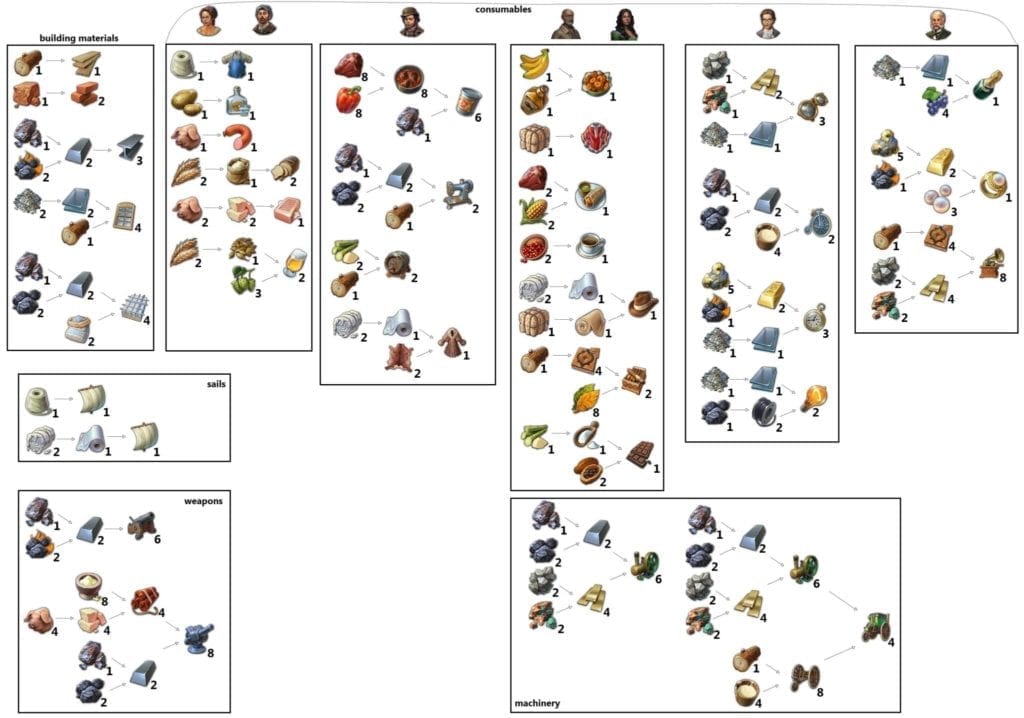
This is a tad bit hard to memorize, but do keep checking it from time to time especially when planning your island’s layout. Also, don’t forget to have warehouses near building chains so they can go straight to your pool of goods.
Land Grabbing And Island Fertility
Although your starting island may have the resources you need to reach newfound prosperity, chances are that it might lack fertility for certain crops. It might also lack certain mines that can be built later on. That’s where land grabbing comes in.
You’ll need a ship with two cargo holds (your flagship has this role early on), along with 2,500 gold, 10 timber, and 8 steel beams. Transfer these resources to your ship and sail towards the coast of any unsettled island, making sure it has the type of fertility or mines that you’d want. Build a trading post and you’re all set.
From there, you can create specialty islands. These are basically islands dedicated to producing specific goods that you’d want. For instance, if an island has hops and pepper fertility, you could just focus on making beer and canned food there.
Naturally, your new islands would need resources to start constructing buildings. You can send these over from your main island. Once you’ve produced the goods, you can take them back to your main island to keep citizens happy or sell them over to the AI.
To transfer resources, you can choose between a trade route or a chartered route. Trade routes require at least one ship, preferably a schooner as they’re easily built once you have a sailing shipyard and they can carry up to two resources. A chartered route, meanwhile, doesn’t require any of your ships although you’d need to pay a small fee to keep it running.
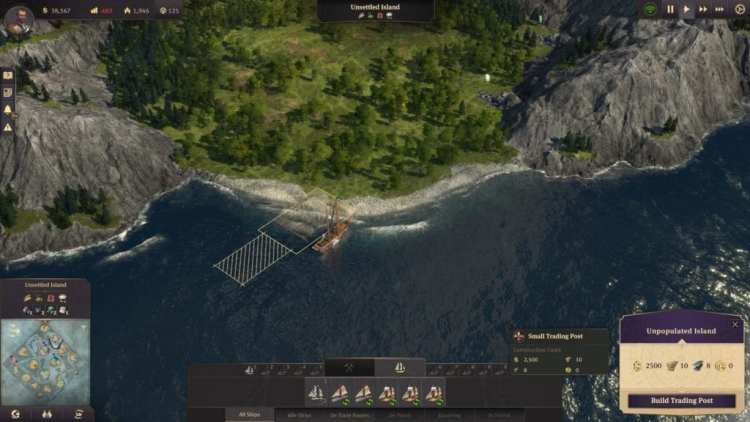
It’s time to settle on a new island. The only one that has pepper in this particular game happens to be way down south.
Trade Routes
Speaking of trade routes, you can start selling goods to neutral NPCs like Madame Kahina or Archibald Blake once you spot them on the map. For other AI rivals, you’ll need to secure a trade charter first via the diplomacy screen. The AI might even have requested resources, and you can choose to sell any extras you have.
For trade routes, click on your main island and load the goods you want. Click on the AI’s island you’d want to sell these to and unload all of them or a specific number. You can even select multiple islands in case you’re dropping off various goods.
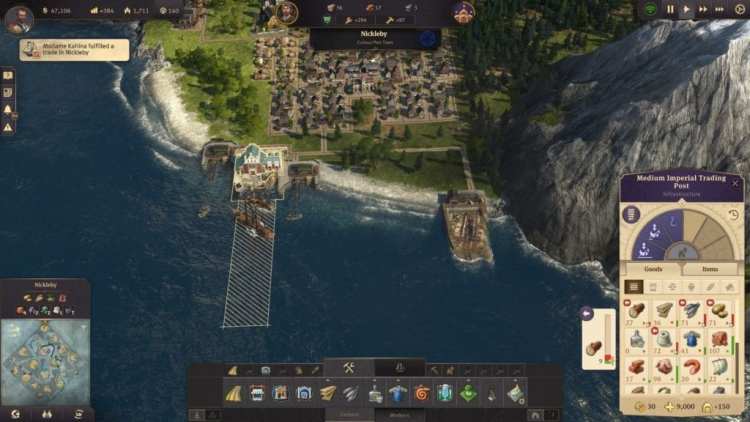
Sell some of those extra resources you have especially if you’re already mass producing them. Be careful, though, because you might run out of reserves unexpectedly, especially when the same product is being sold or sent via multiple trade routes.
Alternatively, just open your trading post’s panel and click on an item until you see the “Sell” slider. Choose how much you’d want to trade away. Ships that need those goods will drop by from time to time. If you do need particular items, use the “Purchase” slider instead. Note that I tend to avoid the “Balance” slider since the automation can be wonky at times.
The main downside to trade routes, however, is something I mentioned in our official review. You won’t be able to see how much you’re earning per good or per trade route. The most that you can check would be from your trading post which will show the purchase/sell price of items, as well as the trade history button there. This isn’t really too helpful especially if you want more control or just additional information to go by, unless you have a handy list and want to compute the value of each trade route manually.
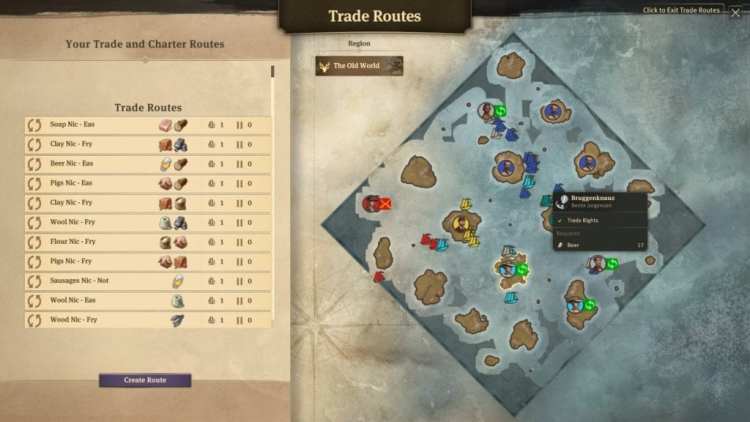
Sadly, the layout for the trade route system is very limited. Worse, the AI keeps spamming you about “pent-up gas.”
Don’t Be Hasty (When Upgrading Citizen Tiers)
This is a lesson you’ll learn early on. Your workforce in Anno 1800 is divided into citizen tiers. Each tier’s workforce can only be tasked for specific buildings or jobs. Farmers till the fields, which is something artisans or engineers cannot do.
You don’t want to rush upgrading to later tiers, even if you’ve satisfied the previous tier’s needs. There’s a good chance you can earn more by farming (pun intended) particular resources or goods, and selling them later on.
Likewise, once you do have a new tier of citizens, you’re going to have to focus on keeping them happy as well. This can mean having to construct new building chains specific to that tier, which, in turn, may require more citizens of that type or from the previous one.
Take it slow and steady, ensuring that all the needs are met, and then some, prior to going up a tier. In my case, I waited before getting more workers, and that was only because I needed to recruit schooner vessels for extra trade routes.
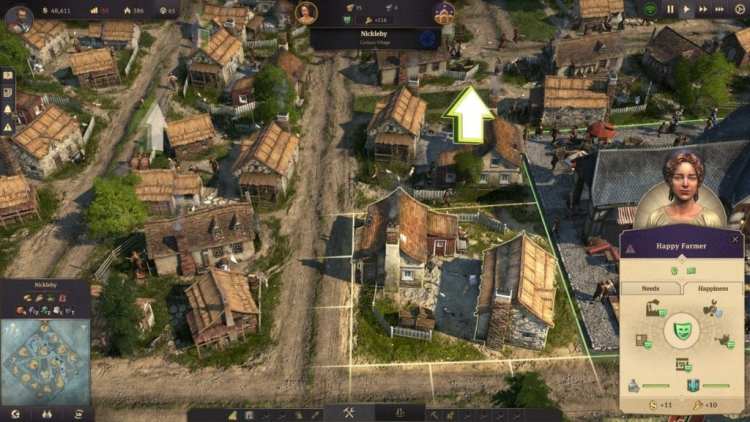
Farmers are the easiest citizen tier to keep happy and productive. No need to quickly rush to other tiers.
Surplus Maximus
To make as much gold or money as possible, you’ll want to get the most out of your workforce. Your island’s population (and citizen tiers) determine how much you’ll receive in taxes. More people means more money, basically.
Remember that part about using specialty islands to create specific goods? You can do something similar to your main island as well simply by spamming farmers and constructing farmer-tier structures. Keep your farmers happy by way of public services, and use your newspaper’s propaganda to boost happiness levels and tax income.
As for the goods they produce, well, if you focus on particular production chains, you can just as easily sell your surplus materials. You’d barely need workers, other citizen tiers, or more advanced buildings since farmers can make you all the gold you need. Yep, that’s one reason not to be hasty in upgrading, since the most basic citizen tier in the game — farmers — can lead to greater riches. It’s a bit gamey and downright boring, but it works.
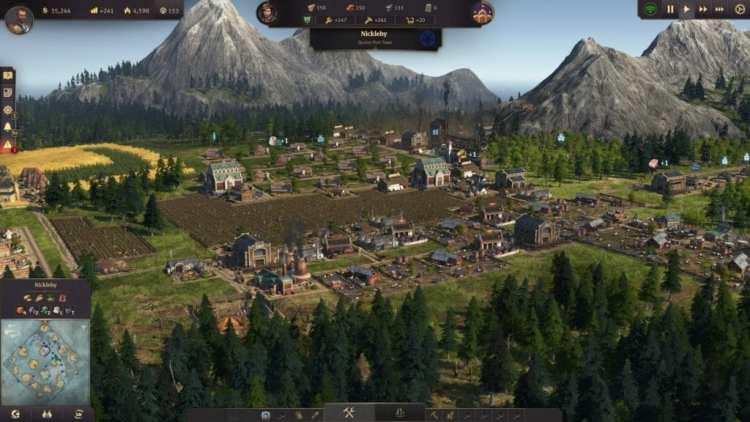
This is my farming district after a couple of hours of playing. I might need an extra production building or two just to attain 100% efficiency for certain chains, but everything looks orderly.
All Roads Lead To Rome
Well, no, your island might not be named Rome, but your roads do need to lead back to your trading post. Not only that, but roads need to connect all your buildings, farms, mines, warehouses, and residences. You also need to ensure that there are facilities that can help improve safety, happiness, and efficiency.
Warehouses are the most important as you’ll always need them near your production chains. They have two loading ramps by default which means two goods can get picked up/stored by your carts roaming around. If you have multiple production chains and only a single warehouse in a location, expect loading to get bogged down a bit unless you upgrade or build another one.
Fire stations and police stations are also important. The former obviously puts out the fires, and the latter stops riots (likely when your citizens are unhappy). Churches, schools/universities, pubs, and other public service buildings are also necessary as they increase citizen happiness. These buildings operate by proximity and you’ll see streets with a strong green outline if those areas are covered.
There are also buildings such as trade unions and town halls, and these offer bonuses to production efficiency, maintenance, or happiness. Structures within their radius of effect gain these bonuses. Museums and zoos, meanwhile, increase tourism for your islands.
Don’t worry if you’ve already built a city accordingly and you need to place new structures. You can always move or demolish older buildings to make way for what’s necessary.

An example of what you don’t want to do: Notice how the green outline becomes lighter further away from the market? The houses don’t even gain their basic needs from it, and citizens are unhappy as a result.
Quests And Expeditions
The last things of note are quests and expeditions. Your AI rivals will sometimes give you quests. These can range from rescuing shipwreck survivors or picking up flotsam, to delivering cargo, taking out enemy ships, and more. You’ll usually get some extra gold and relationship bonuses in return. Various villagers in your settlement can also provide these quests, mostly the Where’s Waldo types. You need to find specific characters like a rioter, a fisherman, a union worker, and the like.
Expeditions, however, are more complex but only slightly. They’d require one ship and you’d want to outfit this vessel with food rations (five fish resources ought to do it), weaponry, and specialists. These specialists provide an extra bonus to certain stats like Crafting, Faith, or Hunting. They also add bonus morale for your ship’s crew.
Once your ship has sailed to uncharted waters, you’ll eventually be notified of certain events for that expedition. These events offer multiple choices, and many of these require a specialist to increase your success rate. Failure in a decision event will lead to a loss of morale. There are numerous events before an expedition is completed, so if you lose all morale, then your ship — and any cargo or specialists onboard — will also be lost.
If you do manage to complete an expedition, you may earn unique items with special bonuses. Some of these can be equipped in trade unions or town halls back on your island, increasing happiness or worker efficiency. Others can be equipped by your warships, improving their combat capabilities.
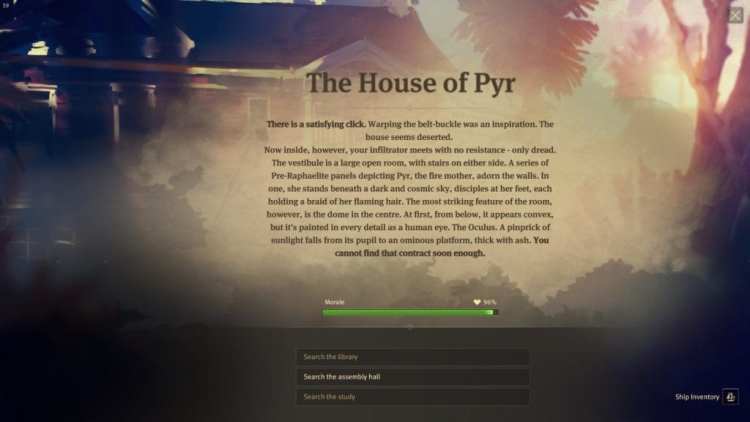
Expeditions, such as this one from the campaign, offer multiple choices. Many would require a particular specialist’s bonuses to increase your success.
That about does it for our Anno 1800 beginner’s guide. Anno 1800 isn’t really about that final victory or reaching your destination. It’s the journey you undertake all throughout, immersing yourself in the voyage.
There are a number of victory conditions you can select prior to starting the sandbox game. Also, you could be well on your way to winning just by amassing gold and boosting your income. Whether you do that from a single island, just with farmers, or by exploring the unknown is completely up to you. That’s the beauty of Anno, the world is your oyster.

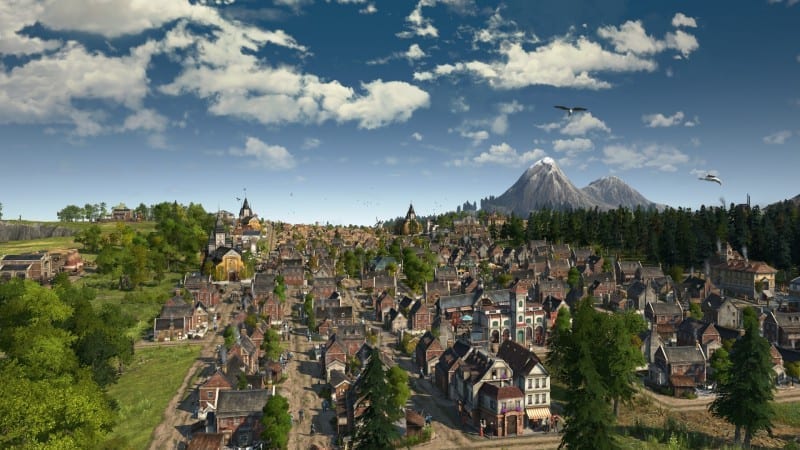
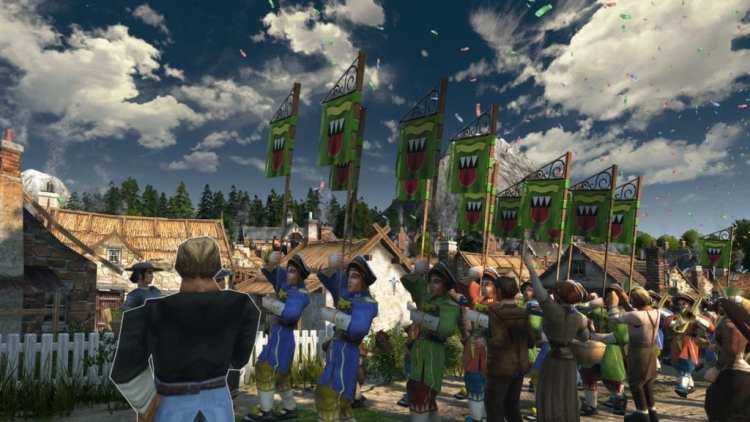





Published: Apr 16, 2019 07:00 am